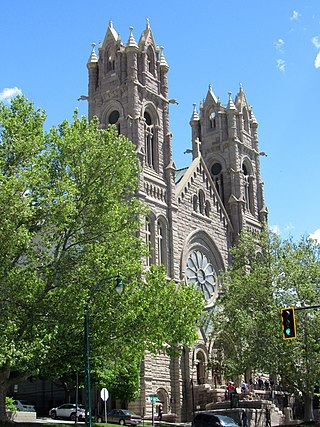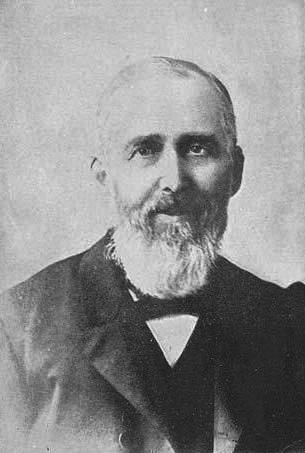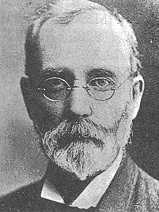Related Research Articles

Calixa Lavallée was a French-Canadian-American musician and Union Army band musician during the American Civil War. He is best known for composing the music for "O Canada," which officially became the national anthem of Canada in 1980, after a vote in the Senate and the House of Commons. The same 1980 Act of Parliament also changed some of the English lyrics. A slight alteration to the English lyrics was made again in 2018. The original French lyrics and the music, however, have remained unchanged since 1880.

The Notre-Dame Cathedral Basilica is a Roman Catholic minor basilica in Ottawa, Ontario, Canada located on 385 Sussex Drive in the Lower Town neighbourhood. It was designated a National Historic Site of Canada in 1990.

The Cathedral of the Madeleine is a Roman Catholic church in Salt Lake City, Utah, United States. It was completed in 1909 and currently serves as the cathedral, or mother church, of the Diocese of Salt Lake City. It is the only cathedral in the U.S. under the patronage of St. Mary Magdalene.
Alfred Ernest Whitehead was an English-born Canadian composer, organist, choirmaster, music educator, painter, whose works are held in a number of important private collections, and an internationally recognized authority in the field of philately. His The Squared-Circle Cancellations of Canada received its third edition shortly after his death.
François Joseph Brassard was a Canadian ethnomusicologist, organist, composer and music teacher.

St. Vincent de Paul Church is a Roman Catholic parish and Los Angeles Historic-Cultural Monument in the South Los Angeles section of Los Angeles, California. The church was built in the 1920s and designed by architect Albert C. Martin, Sr. Paid for by local oilman Edward L. Doheny and thus is known colloquially as "the Church of Holy Oils." It was dedicated in 1925, it was located in what was then one of the wealthiest sections of the city, on land adjacent to the Stephen Dorsey mansion and Stimson House. It was the second Roman Catholic church in Los Angeles to be consecrated. Composer Amédée Tremblay notably served as the church's organist from 1925–1949. Tremblay was succeeded as organist by the British-born musician John Lee.

Charles Albert Edward Harriss was an English then Canadian composer, impresario, educator, organist-choirmaster and conductor.

Joseph Pierre Alexis Contant was a Canadian composer, organist, pianist, and music educator. Trained as a pianist, he became one of the first Canadians to compose large-scale choral and orchestral works, in spite of the difficulty of finding suitable teachers of musical composition. His younger years were spent mostly in teaching, family, and work as a church organist, and many of his compositions were written later in life.
Joseph Eugène Raymond-Marie Daveluy was a Canadian composer, organist, music educator, and arts administrator. An associate composer of the Canadian Music Centre, his compositional output consisted mainly of works for solo organ. He had an active international career as a recitalist and concert performer from 1946 through the 1990s. He held a number of church posts in Montreal, including serving as organist of St-Jean-Baptiste Church (1946–1951), Immaculée-Conception Church (1951–1954), and St-Sixte Church (1954–1959). In 1980, he was named a Member of the Order of Canada. He was married to pianist Hilda Metcalfe.

Adélard Joseph François-Arthur Boucher was a Canadian publisher, importer, choirmaster, organist, conductor, writer on music, composer and numismatist. In 1865 he founded the A.J. Boucher Co. in Montreal which published the works of Canadian and foreign composers until it closed in 1975. In 1862, he founded the Société de numismatique de Montréal, serving as the organization's first president. He composed several works for solo piano, of which his most well known are Coecilia, a mazurka caprice; Les Canotiers du St-Laurent, a 'quadrille canadien'; Jolly Dogs Galop; and Souvenir de Sabatier, a suite of waltzes. Most of his compositions were written and published before 1866.
Oscar O'Brien was a Canadian folklorist, composer, pianist, organist, music educator, and Roman Catholic priest. A large portion of his compositions were based in folklore and he also arranged and harmonized roughly 400 French and Canadian folksongs; many of which were written for his collaborations with Charles Marchand and the Alouette Vocal Quartet. He worked as an arranger or accompanist on numerous 78 rpm recordings for such labels as Bluebird, Brunswick, Columbia, Starr, and Victor. He contributed numerous articles on folklore to publications like Le Canada français and was a frequent lecturer on folklore subjects. In 1978 CBC Radio recognized O'Brien in a series of six broadcasts featuring his harmonizations.
George Amédée Tremblay was a Canadian pianist, composer, and author who was active in the United States. Although his works display a broad range of stylistic influences, he is primarily associated with the twelve-tone technique. He is the author of the musical treatise The Definitive Cycle of the Twelve Tone Row. Tremblay was also noted for his unique capacity to extemporize on the piano and frequently performed as an improviser.
Orpha-F. Deveaux was an American organist, pianist, and music educator. Born in Saginaw, Michigan, he studied at the New York College of Music with Mat Schmidt and privately in Montreal with Alexis Contant and Percival J. Illsley. He began working as an organ and piano teacher in Montreal circa 1901 and in 1905 he obtained the post of organist at Église Tres-St-Nom-de-Jésus Church in that Hochelaga/Maisonneuve. He became a faculty member and secretary of the Conservatoire national de musique in 1914, where he taught courses in organ, piano, theory, and harmony. Among his notable pupils were Claude Champagne, J.-J. Gagnier, Paul Pratt, and Hedwige Saint-Jacques. He left Montreal in 1923 to assume the post of organist with the Dominican fathers in Fall River, Massachusetts. He died in Hartford, Connecticut in 1933.
Joseph-A. Fowler was a Canadian composer, organist, choirmaster, pianist, and music educator. His compositional output mainly consists of sacred music, although he did compose some secular songs for voice and piano and a number of works for solo piano. He wrote two masses for choir and orchestra: Mass of the Blessed Virgin Mary and Mass of the Sacred Heart.
Henri Gagnon was a Canadian composer, organist, and music educator. He spent 51 years playing the organ at the Notre-Dame Basilica-Cathedral of Quebec City where, according to music historian François Brassard, he earned "a prestige similar to that of the famous organists of Europe". He was a much admired teacher and taught at several institutions, notably succeeding Wilfrid Pelletier as the second director of the Conservatoire de musique du Québec à Québec. As a composer, he produced mainly works for solo organ and piano; although he did write a few choral works and vocal pieces as well. One of his more popular works was Rondel de Thibaut de Champagne which Edward Johnson and Rodolphe Plamondon often performed in their recitals. Two of his works, Mazurka (1907) and Deux Antiennes, were recorded by the CBC Montreal Orchestra.
Romain Pelletier was a Canadian organist, choir conductor, composer, and music educator. His compositional output consists entirely of works for solo organ and motets. He was a founding member of the Société des artistes musiciens de Montréal and was a much admired teacher of counterpoint, fugue, and the organ.

Romain-Octave Pelletier I was a Canadian organist, pianist, composer, writer on music, and music educator.
Georges-Émile Tanguay was a Canadian composer, organist, pianist, and music educator. An associate of the Canadian Music Centre, his compositional output is relatively small; consisting of 4 orchestral works, 4 chamber music pieces, 9 works for solo piano, 2 works for solo organ, and 4 choral works. The library at Université Laval holds many of his original manuscripts and his personal papers.
Benoît Fidèle Poirier was a Canadian organist, composer, and music educator. He was a church organist and taught at several educational and religious institutions in Montreal, Quebec. He created a number of compositions for organ and piano.

Jean-Marie Beaudet was a Canadian conductor, organist, pianist, radio producer, and music educator. He had a long career with the Canadian Broadcasting Corporation, serving variously as a music producer, programing director, conductor, and administrator. With the CBC Symphony Orchestra he conducted the premiere recordings of works by many Canadian composers, including pieces by Maurice Blackburn, Claude Champagne, J.-J. Gagnier, Clermont Pépin, and Healey Willan.
References
- 1 2 3 4 Gilles Potvin. "Amédée Tremblay". The Canadian Encyclopedia . Archived from the original on 20 December 2010. Retrieved 25 April 2010.